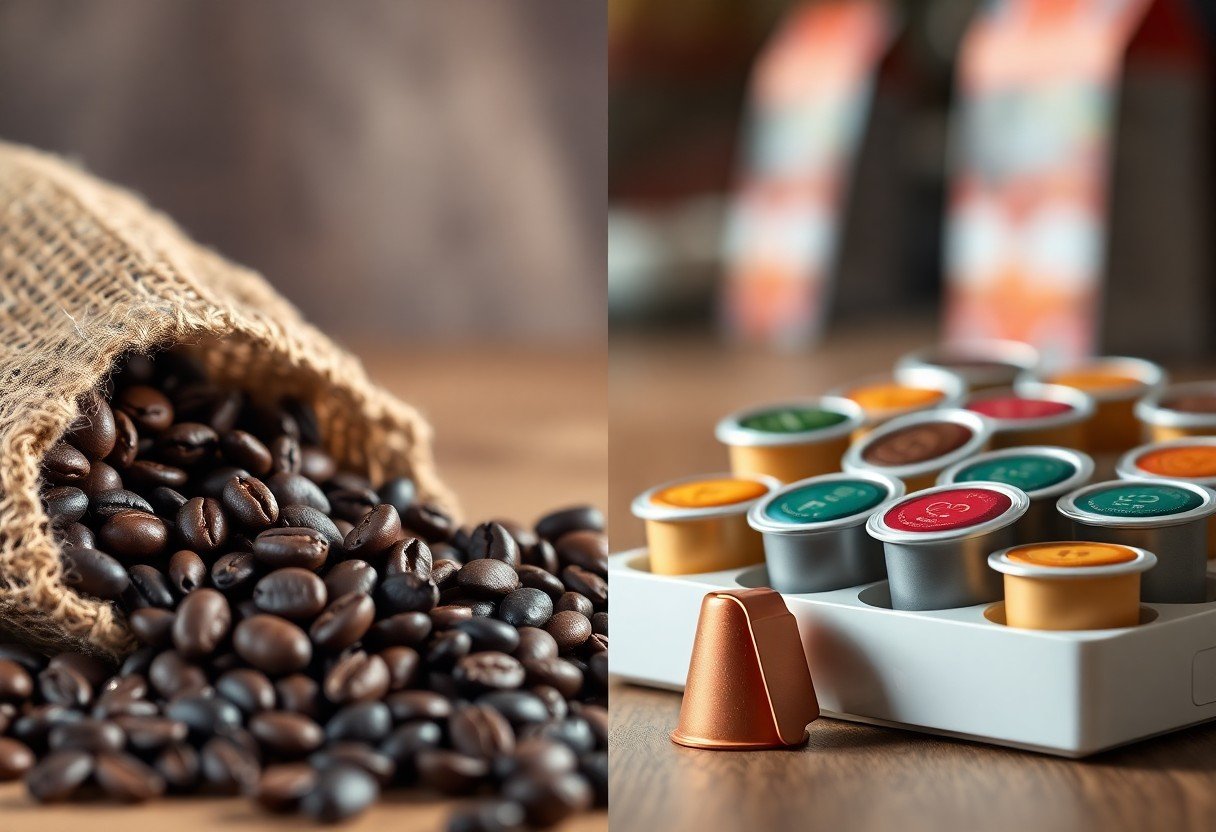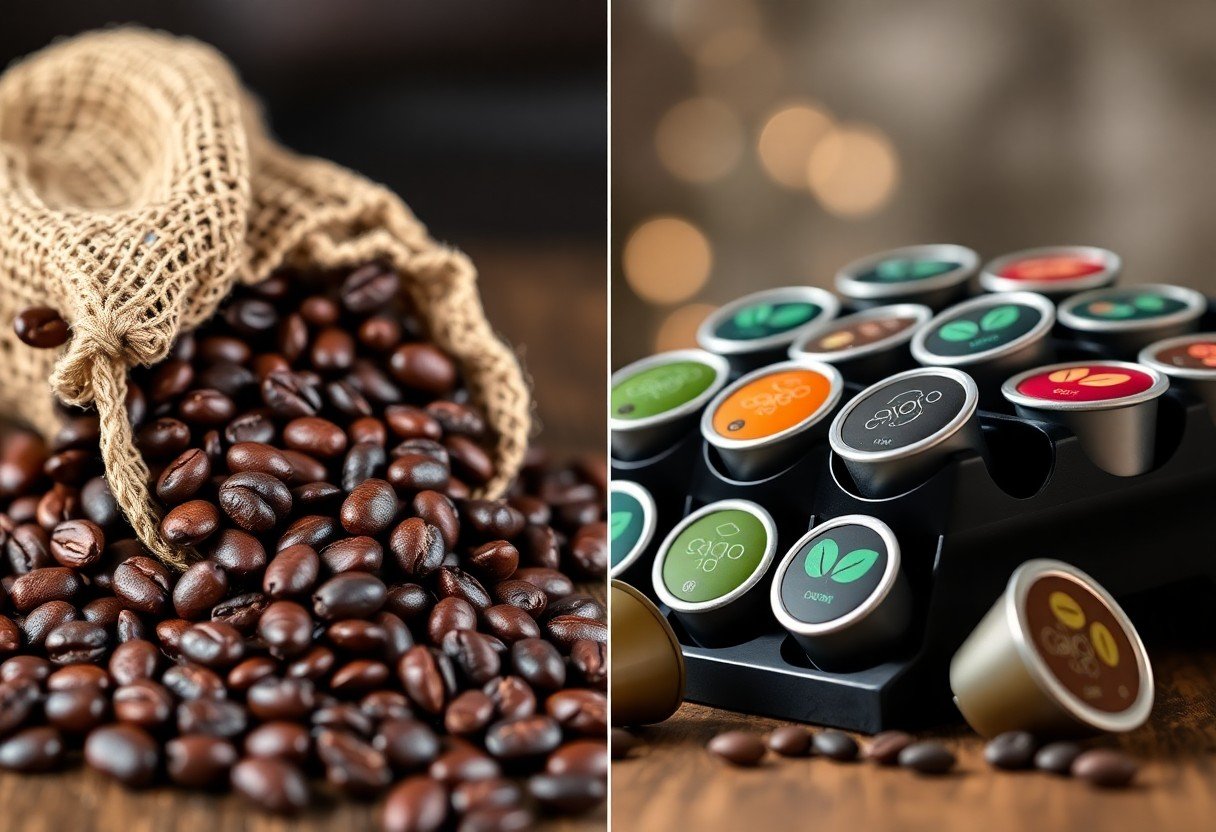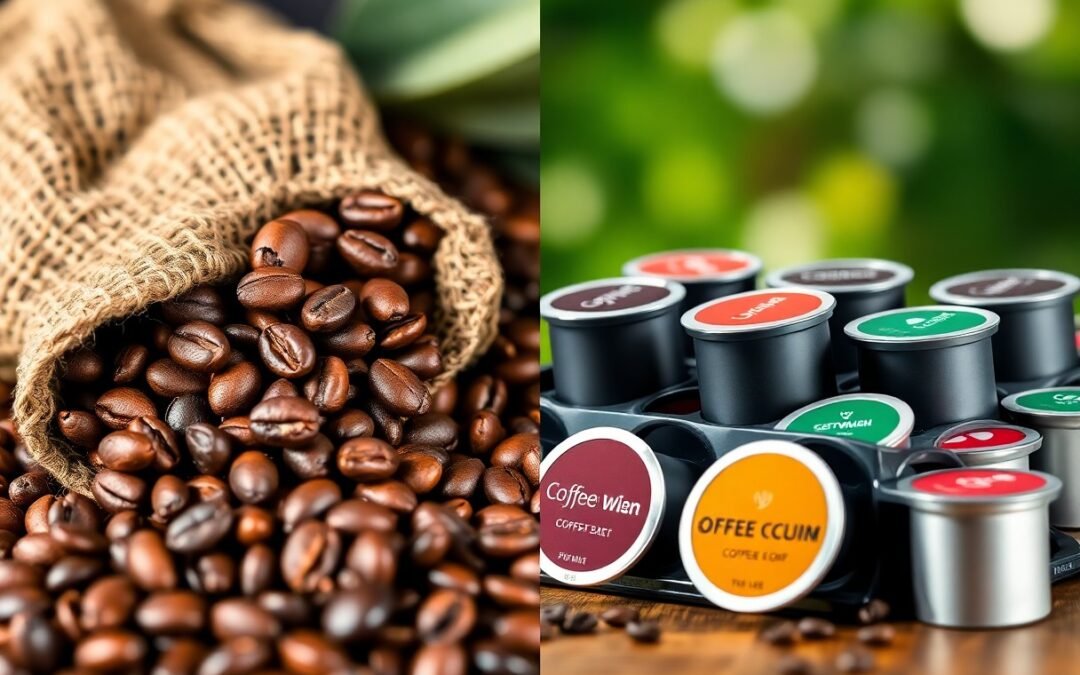Many coffee enthusiasts find themselves torn between brewing traditional coffee beans and the convenience of coffee pods. In this guide, you will explore the benefits and drawbacks of each option, helping you make an informed decision based on your preferences for convenience and quality. From flavor profiles to preparation methods, this article will equip you with the insights needed to elevate your coffee-drinking experience, allowing you to enjoy the best of both worlds.
The Allure of Coffee Pods: Convenience Redefined
The rise of coffee pods has transformed brewing habits, making coffee preparation an effortless task for countless enthusiasts. With single-serve options readily available, you can easily brew a fresh cup without the hassle of measuring or grinding beans. Designed for speed and simplicity, coffee pods are marketed as the ultimate solution for busy mornings or on-the-go lifestyles, allowing you to indulge in your caffeine fix with minimal fuss.
Speed and Simplicity in Brewing
Using coffee pods streamlines your morning routine; just pop a pod into the machine, press a button, and in mere minutes, you’ll have a steaming cup of coffee ready to enjoy. This no-mess, no-fuss approach appeals to those who prioritize efficiency over the traditional brewing methods, saving you valuable time during hectic mornings or work-from-home afternoons.
Waste and Environmental Trade-offs
Despite their convenience, coffee pods contribute significantly to environmental waste, with billions of single-use capsules ending up in landfills each year. While some brands are now offering recyclable or biodegradable options, many still contain plastic components that hinder recycling efforts. You might find yourself grappling with the sustainability of your morning brew, balancing convenience with environmental considerations.
The coffee pod industry’s environmental impact raises important questions about sustainability and waste management. For example, estimates suggest that in 2020 alone, over 500 billion coffee pods were consumed worldwide, contributing to an alarming increase in plastic waste. Brands that offer compostable alternatives show promise, yet the majority of popular pods remain landfill-bound. As you enjoy your quick cup of joe, it’s worth considering the long-term effects on the planet and exploring ways to minimize your footprint while satisfying your caffeine cravings.
The Craft of Coffee Beans: Quality in Every Grind
With coffee beans, each step from sourcing to grinding significantly influences the final cup you savor. Quality beans offer a rich tapestry of flavors and aromas waiting to be unveiled through proper preparation. When you choose whole beans, you possess control over the grind size tailored to your preferred brewing method, tapping into the true essence of the coffee’s unique characteristics.
Flavor Profiles and Freshness Factors
Flavor profiles of coffee beans vary dramatically based on origin, roast level, and freshness. The moment the beans are ground, they begin to lose volatile compounds that contribute to taste. A few factors that play into achieving the best flavor include:
- Bean origins: Different regions yield distinct flavors, such as fruity, nutty, or earthy notes.
- Roast levels: Light roast preserves acidity and fruity flavors, while dark roast veils them in bold, smoky undertones.
- Grinding time: Freshly ground coffee captures aroma better than pre-ground options.
- Your storage practice: Keeping beans in airtight containers away from light extends their freshness.
This focus on freshness ensures you enjoy a vibrant and complex cup every time.
Brewing Methods and Their Impact
Each brewing method extracts flavors and aromas differently, further highlighting the significance of quality beans. Techniques such as pour-over, espresso, and French press require varied grind sizes and extraction times, enhancing or muting certain attributes in the coffee. Mastering these methods can reveal the full potential of your carefully chosen beans, ensuring that you uncover the nuances with every cup.
For example, a fine grind is optimal for espresso, allowing for quick extraction of concentrated flavors, while a coarse grind suits the French press, yielding a rich and full-bodied taste. Pour-over methods often benefit from medium grinds, promoting even extraction and clarity of flavor. By tuning your brewing approach to the specific grind size and coffee type, you unlock the true essence of the coffee’s character, enabling an exceptional beverage experience tailored to your personal preferences.

The Cost Factor: A Financial Breakdown
Evaluating the cost of coffee beans versus coffee pods involves more than just upfront prices; it’s about dissecting your overall coffee consumption and whether convenience outweighs quality in your budget. While pods may seem inexpensive at first glance, their cumulative cost over time can add up quickly. On the other hand, bulk coffee beans can offer significant savings in the long run, especially if you’re a daily coffee drinker who values quality and flavor.
Initial Investment vs. Long-Term Value
Investing in a good grinder and coffee maker for beans can feel steep initially, with prices reaching upwards of $100 for quality equipment. In contrast, the low-cost entry of a pod machine often starts at around $30, making it an appealing choice for those seeking immediate gratification. However, once you factor in the ongoing costs of purchasing pods consistently, bean users can find their long-term expenses dwindling significantly, leading to greater economic value over time.
Cost of Quality: Beans vs. Pods
Choosing between coffee beans and pods can greatly influence the quality of your brew and your wallet. Quality whole beans can range from $10 to $20 per pound, yielding about 40 to 50 cups of coffee, whereas premium coffee pods can cost anywhere from $0.50 to $1 each. Over weeks and months, this price disparity becomes apparent, especially if you tend to consume multiple cups daily. With beans, you often have more control over freshness and flavor profiles, allowing you to savor exceptional quality without sacrificing your budget.
When you consider the cost per cup, coffee beans generally outperform pods in terms of quality and economy. For instance, if you purchase a $15 bag of coffee beans and brew 50 cups, your cost per cup is approximately $0.30. Conversely, with pods priced at $0.75 each for comparable quality, your daily brew can quickly become more costly. Many aficionados argue that the nuanced flavors and aromatics from freshly ground beans justify their expense, making them not just a financial choice but also an investment in your coffee experience.

Taste Test Showdown: An Experiential Comparison
Diving into a taste test can reveal surprising results when comparing coffee beans with coffee pods. You might expect one to dominate on flavor, yet many find that the nuanced profiles of freshly ground beans can stand up remarkably well against the convenience of pods. For a deeper exploration of this battle, check out Coffee Pods vs. Ground Coffee vs. Instant Coffee.
Comparison Breakdown
| Parameter | Beans | Pods |
| Flavor Intensity | Rich and robust | Simplified, varied |
| Preparation Time | Longer (grinding, brewing) | Quick (just pop and brew) |
| Cost per Cup | Generally lower | Higher cost |
| Environmental Impact | Reusable, eco-friendly | More waste, single-use |
Brewing a Side-by-Side Flavor Experiment
A simple way to assess the difference is to brew a side-by-side experiment, preparing both whole bean and pod coffee simultaneously. Use the same water temperature and brew time to create a level playing field, allowing you to compare aroma, taste, and mouthfeel directly. You’ll often find the freshly ground beans exhibiting a more complex flavor profile, while pods may provide a more straightforward, consistent taste.
Expert Opinions and Consumer Preferences
Industry experts generally agree that freshly ground coffee beans deliver superior flavor compared to coffee pods, which can sometimes lack depth. Consumers often gravitate towards pods for their convenience, but surveys indicate that many would prefer the taste of ground coffee if time wasn’t a constraint. This highlights a fascinating dichotomy: while your taste buds may advocate for quality beans, your busy schedule may endorse the practicality of pods.
Numerous surveys of coffee drinkers reveal that around 62% prioritize flavor quality, yet almost 75% lean towards pods for everyday convenience. This split vividly illustrates the ongoing battle between the ideal and the practical. While bean enthusiasts advocate for investing time in the brewing process, many casual drinkers choose the ease of pods, suggesting room in the market for potentially superior pod options that offer enhanced flavor without sacrificing convenience.
Your Coffee Lifestyle: Aligning Choices with Expectations
Frequency of Coffee Consumption and Preparation
Your daily coffee consumption habits significantly influence your decision between coffee beans and coffee pods. If you enjoy multiple cups throughout the day, investing in quality coffee beans may be worthwhile, as they often yield more cups per bag than pods do per box. Conversely, if you prefer a single cup in the morning, coffee pods offer unmatched convenience without sacrificing taste, allowing for quick preparation that fits a fast-paced lifestyle.
Analyzing the Trade-offs in Your Daily Routine
Balancing convenience with quality is a common dilemma in your coffee routine. Coffee pods typically deliver a simpler, faster brewing process, which can save you valuable time on busy mornings. However, when you venture into using coffee beans, you gain control over grind size, brew strength, and flavor nuances, which can elevate your coffee experience significantly. This decision may come down to your tolerance for an extra few minutes of preparation time in exchange for a superior coffee flavor, making it crucial to assess how each option integrates into your lifestyle.
Assessing the trade-offs involves considering how each brewing method affects your overall routine. The minimal time required to use coffee pods may suit mornings when every second counts, while dedicating time to grind and brew beans might enhance your coffee-drinking ritual, making it a cherished moment in your day. If you find yourself rushed, pods will likely fit seamlessly into your routine. Alternatively, if you envision yourself savoring each brewing process and a coffee experience that goes beyond mere consumption, investing time in coffee beans is undoubtedly rewarding.
Final Words
With this in mind, your decision between coffee beans and coffee pods should weigh both convenience and quality. Coffee beans offer a fresh, customizable brewing experience, while pods provide ease of use with consistent results. Assess your lifestyle, taste preferences, and how much time you’re willing to invest in your coffee-making routine. By understanding the strengths of each option, you can select what best fits your needs and enjoy your daily cup to the fullest.
Q: What are the main differences in convenience between coffee beans and coffee pods?
A: Coffee beans require a bit more preparation than coffee pods. With beans, you need to grind them before brewing, which can be time-consuming, especially if you’re in a rush. Additionally, you’ll need a coffee maker or brewing method that accommodates the beans, such as a French press or an espresso machine. On the other hand, coffee pods are designed for quick use. They come pre-measured and often pre-ground, making it easy to brew a cup of coffee in a matter of minutes by simply inserting a pod into a compatible machine. This simplicity makes coffee pods an attractive option for those with busy lifestyles or for those who prefer minimal cleanup.
Q: How do the flavors and quality of coffee beans compare to coffee pods?
A: Generally, coffee beans are considered to offer a superior flavor profile compared to coffee pods. Freshly ground beans can capture the full range of flavors and aromas, providing a more robust and richer coffee experience. The quality of the beans themselves can greatly influence the taste, and many enthusiasts argue that using whole beans allows for a better customization of brewing methods and coffee strength. Conversely, while coffee pods can still produce decent coffee, they may use lower-quality coffee that can lose some of its freshness over time due to packaging. Some brands offer high-quality pod options, but the flavor and aroma may still not fully match that of freshly ground beans.
Q: Which option is more environmentally friendly: coffee beans or coffee pods?
A: With respect to environmental impact, coffee beans are typically a more sustainable choice. Coffee beans usually come in bulk packaging, often with less plastic waste as compared to coffee pods, which often use non-recyclable materials and create significant amounts of waste. Some companies now offer recyclable pods, but they still don’t match the overall eco-friendliness of whole bean coffee. Additionally, purchasing coffee beans in bulk can also reduce packaging waste further. Choosing environmentally responsible brands or those with eco-friendly packaging can also help reduce your footprint whether you choose beans or pods, but whole beans generally have the edge in terms of sustainability.

